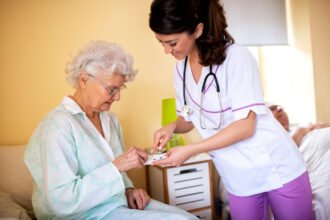The Role of Ultrasound Guidance in Heart Valve Procedures
 How ultrasound aids the detection and treatment of valve dysfunction in minimally-invasive procedures
How ultrasound aids the detection and treatment of valve dysfunction in minimally-invasive procedures
The Role of Ultrasound Guidance in Heart Valve Procedures
 How ultrasound aids the detection and treatment of valve dysfunction in minimally-invasive procedures
How ultrasound aids the detection and treatment of valve dysfunction in minimally-invasive procedures
According to the American Heart Association, more than five million Americans are diagnosed with heart valve disease each year*. Diseases of the aortic and mitral valves are the most common, affecting more than five percent of the population. Valve disease can be caused by a number of ailments, including viral infections and high blood pressure, and can result in regurgitation, a condition where blood leaks backward through the valve. Some cases of valve regurgitation are not life-threatening and can be treated with medication or other methods. More severe cases, however, require surgical intervention to repair or replace the dysfunctional valve to reduce the regurgitation.
Detection and Assessment of Regurgitation with Transesophageal Echocardiography
There are many ways to identify and evaluate valve disease and regurgitation with transthoracic applications. One way to get a complete view of the structure and function of the heart valves is with transesophageal echocardiography (TEE). TEE is a method of ultrasound imaging using a specialized transducer to visualize the structure and function of the heart from within the body. During the assessment, a TEE probe is inserted through the mouth, into the esophagus and positioned near the heart to acquire close range ultrasound images of functional anatomy and valvular flow.
Today, three-dimensional (3D) TEE is rapidly becoming the new standard in the evaluation of valvular disease, surgical planning and guidance for minimally-invasive repair/replacement. This method allows physicians to visualize structures of the heart valves that have previously only been obtained through open heart surgery.
Valve Surgery Guidance
When a valve is not working properly and the regurgitation is serious enough to require an intervention, the main options are to either repair the valve or replace the valve with an artificial one. One of the biggest advantages of 3D TEE is that it allows these repairs to take place during minimally-invasive procedures. Minimally-invasive procedures provide more treatment options for patients who are not eligible for surgery.
3D TEE is a common application for procedural guidance during valve surgery to repair/replace the mitral and aortic valves:
Mitral Valve Repair/Replacement – When the mitral valve (the valve between the left atrium and the left ventricle) doesn’t close properly, surgeons can use 3D TEE in combination with ultrasound-guided methods to either repair the valve or replace it with a prosthetic MitraClip® to correct the regurgitation.
Transcatheter Aortic Valve Replacement (TAVR) – Also known as transcatheter aortic valve insertion (TAVI), TAVR is a minimally-invasive procedure using ultrasound guidance to treat aortic stenosis by implanting a replacement aortic valve using a catheter through the femoral artery.
Currently only non-surgical patients are candidates for TAVR/TAVI and MitraClip® procedures. But as information becomes more readily available to the general population, more and more patients are asking for these types of minimally-invasive procedures to avoid open heart surgery.
Limitations of Current Imaging Methods
After a procedure to repair or replace dysfunctional heart valves, it is important to quantify the residual regurgitation and determine if the replaced valve is correctly seated and rule out any perivalvular leakage around the outside of the valve. The current 3D method of evaluating the function of the heart valves is usually limited to capturing clips of only a portion of the heart in a single heartbeat. These clips are then “stitched” together to form a general representation of heart valve function and blood flow. This means that in order to obtain a complete view of the entire heart anatomy and physiology, several different views of the valve must be captured in successive heart cycles. One of the limitations of this “stitching” method is that heart cycles can vary beat-to-beat, especially in patients with arrhythmia. In addition, movement from the patient’s breathing causes motion artifacts in these stitched images.
It would be optimal to be able to get a full view of the whole valve in real-time, without stitching. This may allow improved evaluation and quantification of residual regurgitation or perivalvular leaks and provide 3D imaging for all patients, regardless of any ECG abnormalities.
Future Trends in Interventional Guidance
In some clinics there is exploration of the use of intra-cardiac echocardiography (ICE) for image guidance instead of with TEE. ICE imaging is enabled by a catheter with the ultrasound imaging technology on its tip. The ICE catheter is inserted into the vascular system and passed through to the heart for a very close look at the heart walls and valves. Because this eliminates the need to have the TEE transducer in place for extended periods of time, ICE imaging makes it possible for the procedures to be done with the patient under conscious sedation rather than general anesthesia. Physicians may see this as an advantage for some procedures or in some patients, as the use of general anesthesia often requires longer recovery time and may not be indicated for some very sick patients. Advantages for this are still being evaluated and proven at a limited number of institutions around the world.
In the interventional suite, when physicians have a patient’s life in their hands, seconds matter. Surgeons are responsible for performing these procedures with precision and need be able to react quickly when conditions change. The future of 3D TEE and ICE technology should aim to provide these physicians with rapid and complete information in more patients, allowing them to make better real-time decisions about the status or success of a procedure.
*American Heart Association. Heart Disease and Stroke Statistics 2010 Update. Dallas, Texas: American Heart Association; 2010.
heart surgery / shutterstock







